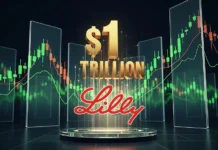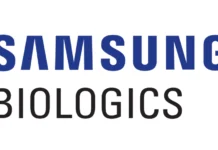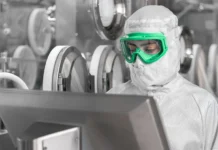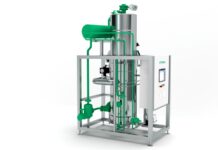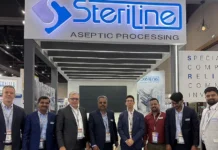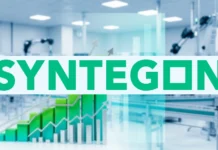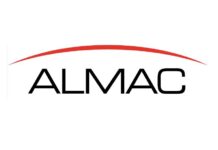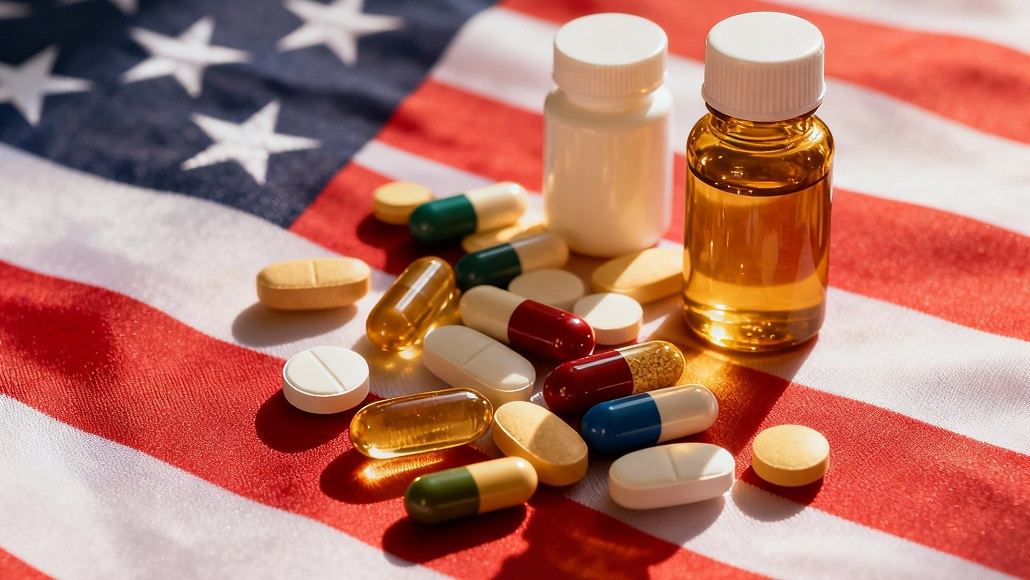The announcement made by President Donald Trump that his administration is going to impose a 100% tariff on patented pharmaceutical products went on to spark tremendous confusion as government officials, drug companies, and trade groups looked out for clarity on how the tax imposition is going to be applied. The plan went on to deliver one clear mandate, however – It sent drugmakers running around to show that they are indeed building manufacturing capacity across the United States.
In a Truth Social post that went live late September 2025, Trump went on to say that the brand-name prescription drugs are going to be subject to tariffs until and unless their manufacturers are building plants across the United States actively. There is going to be no tariff on the pharmaceutical products if construction has begun, said the post.
Apparently, the reaction from drugmakers has been pretty fast. According to Mike Doustdar, CEO, the cranes at present are rising pretty fast at the US manufacturing site of Novo Nordisk in North Carolina. It is well to be noted that the Danish company goes on to produce the Ozempic and Wegovy weight-loss as well as diabetes drugs.
Amgen, which happens to be California-based, went on to announce a $650 million expansion on September 26 at its manufacturing facility based in Puerto Rico.
The move goes on to spike the uncertainty of U.S. trade policy at the moment when U.S. courts are weighing the legality of Trump’s earlier tariffs and there are many Americans who are facing the prospect of higher health insurance premiums.
What does the new tariff announcement by Trump mean?
As per his social media post, starting Oct. 1st, 2025, they are going to be imposing a 100% tariff on branded or patented pharmaceutical products, unless and until the company happens to be building its pharmaceutical manufacturing plant in the U.S. Apparently, BUILDING was defined as breaking ground or under construction.
Although the pharmaceuticals were exempt from the broad tariff announcement in April 2025, extra levies on the products were anticipated to come to the fore and the new tariff announcement by Trump are indeed an eye-opener.
Nonetheless, there was confusion on how exactly these tariffs are going to be applied, since the experts went on to note that the post by Trump did not make clear if the tariffs were levied on countries that had already gone ahead and established trade deals with the U.S. or whether the exemptions had also been applied to companies that already had their manufacturing factories based in the U.S.
European Union trade officials, for instance, stressed the fact that they anticipated tariffs on E.U. pharmaceutical companies to have a cap at 15% given the clear all-inclusive 15% tariff ceiling when it comes to E.U. exports and went on to include the recent trade deal that took place between the United States and the E.U.
Simon Harris, the Irish Trade Minister, said that his government would indeed be studying the impact of the announcement but also stressed that the U.S.-E.U. trade agreement went on to make absolutely clear that sort of a new U.S. tariff on pharmaceuticals is going to be capped at 15%.
The European Federation of Pharmaceutical Industries and Associations went on to call for urgent discussions pertaining to how to avoid any sort of tariffs on medicines that harm the patients, noting that the E.U. as well as the U.S. have a trade agreement in place already.
It is well to be noted that the European countries that are not part of the E.U. remarked that they are going to be reviewing the announcement, while at the same time acknowledging that it went on to cause some level of concern or confusion.
The U.K. government remarked in a statement that the announcement was indeed very concerning for industry; however, the government is going to be continuously engaging with the US.
There are many European drugmakers who have recently announced their plans to boost their manufacturing across the U.S., potentially protecting them from the new tariffs.
Novartis, the Swiss pharmaceutical company, said that the announced 100% tariff should not have an effect on the company. Roche, the Swiss drug developer that goes on to make the popular flu drug Tamiflu as well as the acne treatment Accutane, went ahead and recently announced its investment into a manufacturing site in the U.S. And in July 2025, AstraZeneca, the British-Swedish company, committed to investing $50 billion in the construction of a facility based in Virginia, which would make ingredients for the weight-loss as well as metabolic drugs.
But the trade groups, which represented the businesses as well as pharmaceutical companies, were indeed critical of the announcement.
As per the CEO of the Biotechnology Innovation Organization, John Crowley, the immediacy of punitive and 100% tariffs when it comes to innovative medicines for any company without the shovels in the ground would indeed devastate the small and mid-sized biotechnology companies of their country.
The director general of the European Federation of Pharmaceutical Industries and Associations Tariffs, Nathalie Moll, said that the increased costs go on to disrupt the supply chains and also prevent patients from having life-saving treatments.
The vice president of strategic policy as well as supply chains for the Canadian Chamber of Commerce, Pascal Chan, remarked that the tariff would indeed go on to have profound and potentially dire consequences when it comes to any Americans’ health since disrupting the supply chain with such a steep tariff is going to lead to an immediate hike in prices, insurance systems that are strained, shortages of hospitals, and also a real risk of patients rationing essential medicines.
He further said that some companies could as well find it impossible to relocate their manufacturing setup to the U.S. quickly due to the bureaucracy as well as the costs that are involved.
Why do tariffs on pharmaceuticals happen to be controversial?
Up until now, pharmaceuticals are exempt from the tariffs rolled out by the Trump Administration; however, the Commerce Department is also investigating the drug imports’ effects on the national security.
Trade associations, along with the lobbyists for pharmaceuticals, have gone on to argue that drugs must be considered separately as compared to other goods due to their role when it comes to the health system.
The American Hospital Association (AHA), as well as some insurers, has also in the past warned that tariffs may raise the price of drugs or, for that matter, the premiums on health insurance.
It is well to be noted that in 1994, a WTO agreement that the U.S. inked scrapped the tariffs as well as other duties on many pharmaceutical products as well as the substances that were used to produce them, therefore keeping them at duty-free levels among the signatories.
A senior fellow at the Council on Foreign Relations, Brad Setser, said that the recent tariffs from the Trump administration aren’t consistent with that WTO agreement, therefore adding that the U.S. can deviate as long as there lies a legal justification such as that of national security.
So, where do the U.S. medications come from?
Apparently, in 2024, the U.S. imported almost $233 billion in pharmaceuticals as well as medicinal products, reported the Associated Press, citing the Census Bureau.
Out of that, $45.5 billion happened to come from the E.U., with the companies shipping in medicines that ranged from vaccines to weight-loss semaglutide injections.
The worldwide supply chain for medicines happens to be very intricate, with medicines often having elements from more than one nation. The fact is that where they are made can also go on to depend on the form that the medicine takes, says the US Pharmacopeia, which is a nonprofit organization that goes ahead and tracks the worldwide drug supply chain.
What complicates things further is that it is indeed quite common for companies to source the APIs from overseas and thereafter assemble the medications in the U.S. Previously the dependence of the U.S. on foreign sources when it comes to major pharmaceutical ingredients has also raised national security concerns along with fears for patients at the time of disruption.
How could these tariffs affect the drug prices?
It is worth noting that imposing a tariff on imported medication happens to be equivalent to taxing it, raising the cost to manufacturers. However, how a tariff goes on to translate into what consumers pay for brand-name prescription drugs happens to be a very complicated formula.
As per Setser of the Council on Foreign Relations, for patent-protected medicines, the consumer effect happens to be quite uncertain, and it gets tied to all the complexities in terms of tax.
Apparently, the pharmaceutical companies can also try to pass the prices to consumers; however, that may meet resistance coming from insurers, who, by the way, are unwilling to accept higher costs. There are some multinational drugmakers who could very well conclude that the U.S. tariff cost is worth paying the higher taxes in order to lessen their duties when it comes to imported drugs. All this goes on to make the prospect of getting an exemption for U.S. manufacturing immensely valuable, as one doesn’t have to alter the tax strategy.
Eli Lilly CEO Dave Ricks, in an interview, remarked that the tariff policy rolled out by the administration changes week to week, and the company cannot depend on it to make notable investments, which, by the way, includes the likes of a $5bn manufacturing facility, which it plans to set up outside of Richmond. If the pharmaceuticals are subjected to tariffs, then, as per him, they would just rebalance where the things are made.
Although the Trump administration has confirmed that the pharmaceutical tariffs happened to be designed to get the drugmakers to make some more medications locally, it is at the same time trying to bring down the drug prices. In letters written to the pharmaceutical executives, Trump has asked them to lower the medications’ cost in the U.S. by Sept. 29. Notably, the 100% tariff that Trump announced is set to go into effect starting October 1, 2025.




